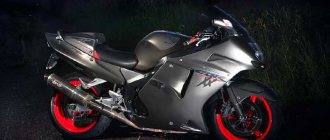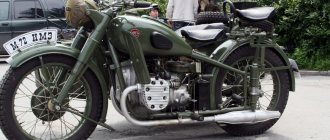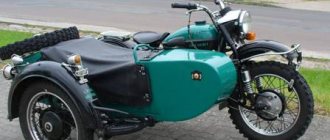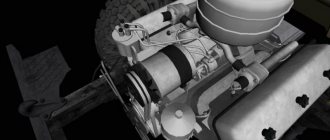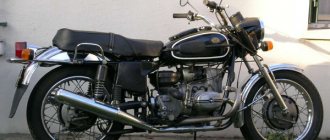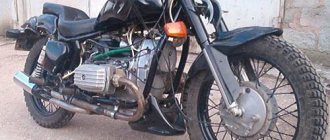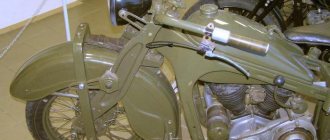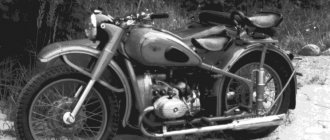Soviet style conversion
In 1955, the military order was transferred to the Kyiv Motorcycle Plant (which produced cars under the Dnepr brand). The Urals had no choice but to switch to civilian consumers. And it is in this market segment that Irbit motorcycles have achieved incredible success.
The first civilian model was the M-72M.
“It was a real workhorse.” In villages and small towns, this motorcycle literally performed the function of a horse: it was easy to bring a haystack or bags of potatoes for fishing. Take it anywhere! — says Alexander Bulanov.
At first, Irbit motorcycles did not have their own brand - only letter designations. The first car with a name was the M-61 model - it was called “Irbit”.
And only in 1961, when the M-62 model was released, Irbit motorcycles received the name “Ural”. At the same time, large-scale production of motorcycles began.
In the 60s of the last century, policemen drove Urals. And in this capacity - a police motorcycle - the “Ural” was often filmed in films. In the photo: an episode from the legendary Soviet film “Beware of the Car!” (1966)
— Our most popular model over the years was probably the M-63 motorcycle. It was produced for 8 years: from 1963 to 1971,” says former plant director Nikolai Volozhanin .
Nikolai Ivanovich will turn 80 this year. He is a living legend of the Irbit Motor Plant; he was its director twice. The first time was from 1979 to 1983, and the second time was at the end of the enterprise’s glory, from 1987 to 1995. He himself had three Urals, in which he participated in long-distance runs.
The most famous of them took place in 1968. Then a team of Irbitsk residents went to an international gathering of, as they would say today, bikers, which took place in Italy. According to the recollections of Nikolai Volozhanin, nine motorcycle plant workers left Irbit on eight locally produced motorcycles. It took 50 days to get to Italian Perugia, where the rally took place, and back; we drove 11 thousand kilometers - and with virtually no breakdowns. Probably, then “abroad” saw the Ural motorcycle for the first time. As Nikolai Ivanovich said, even in the company of eminent brothers, “Ural” looked good. The technical lag of the Irbit motorcycle began later...
The history of the domestic motorcycle brand "Ural"
A motorcycle is a very popular type of transport today, but at the same time it has its own specific features. This transport is more individual than many other vehicles; it does not involve the transportation of a large number of passengers, like, for example, cars. Strictly speaking, it is just an improved bicycle with a motor, but it can reach very high speeds.
One of the main areas of application of motorcycles is sports competitions, but it was very widely used not only for peaceful purposes, but also for military purposes. However, it may be thanks to the military that this type of transport has become so widespread. And the Ural motorcycle played a huge role in this matter in our country, which, despite its German origin, is to this day a respected classic of the domestic motorcycle industry.
The need for military motorcycles in many countries of the world arose in the late 30s, when it became clear: the time of the cavalry had passed, and the “all-terrain” horse should be replaced with something, and quickly. In our country, this was largely facilitated by the grandson of Napoleonic doctor, who remained in Russia after being wounded, engineer and military theorist Ippolit Ippolitovich Dumoulin (1897-1942).
A fan of motorcycles, he actively advocated the creation of motorcycle units in the army, classifying them as "armored vehicles". At that time, the German BMW R71, which had proven itself well in the Wehrmacht, was considered the most successful motorcycle in Europe.
By the way, American designers ripped off their “Harley-Davidson” from him, so the Germans can be considered pioneers not only in the field of aviation and rocket science, but also in motorcycle technology.
In those years, the Stalinist USSR and Nazi Germany made certain steps towards each other in the field of technology exchange, and the Soviet leadership became interested not only in German aircraft, but also in motorcycles. The Germans kindly shared the technology of the outdated BMW model, but the Soviet secret services secretly purchased several of the newest models in a third country, where the new products arrived from Germany, dismantled them piece by piece and also secretly delivered them to Moscow.
The first motorcycle of the Soviet racer Boris Zefirov (1911-1992), with a reinforced frame and an increased gas tank capacity, rode on the cobblestones of Red Square in early 1941 as a purely Soviet invention under the letter M-72, where “M” stands for Moscow and “72” - continuation of the German brand R-71. Stalin approved this model, authorized its production, and three factories at once began to “replicate” the motorcycle, one of which was located in Moscow.
At the beginning of the war, the capital's plant was evacuated away from the approaching front to the Ural city of Irbit, where it occupied the premises of a brewery. An interesting fact: there weren’t enough seats on the train, and the reference model, which today is carefully preserved in the factory museum as a national rarity, rode on the roof of the carriage.
In 1942, arrested on a false denunciation as a German spy, Dumoulin died, but production only expanded. Very soon, the Irbit plant sent the first batch of new motorcycles to the front, where they showed themselves at their best. During the war, about 10 thousand copies were produced with machine guns, anti-tank rifles and even mortars mounted on wheelchairs. During the war, some modifications appeared, but basically the motorcycle did not change much, because the design was initially ideal, the improvements concerned only increasing engine power.
In 1954, Nikita Khrushchev transferred Crimea to Ukraine, and a military order for motorcycles to Kyiv, where the Irbit M-72 began to be produced under the Dnepr brand. The Urals switched to producing this equipment for the civilian population. Until 1961, the motorcycle went under the letter “M”, then for some time it was called “Irbit”, and in 1961 the M-62 brand was named “Ural”. “Urals” were readily purchased by the Ministry of Internal Affairs, and in rural areas it was a real workhorse, capable of carrying up to half a ton of cargo, and for this it rightly received the nickname “beast” among the people. The front-line owners, remembering how the M-72 easily carried light guns during the war, attached homemade trailers to the vehicle.
Technical characteristics of the Ural motorcycle
A heavy two-cylinder motorcycle with a separate carburetor for each cylinder, calm when driving on a flat road (100 km/h), worked true miracles off-road - it was a real all-terrain vehicle. Its main feature was the cardan transmission, reverse gear and all-weather capability. Easy to operate, this “beast” was easily repaired right in the middle of the road with improvised means, and could continue moving on just one cylinder.
One of the modifications had an additional switchable universal joint for the stroller. However, he was not obedient to everyone, he required special control skills, and, like a dexterous horse, he could overturn a beginner into a ditch. The motorcycle was considered “liable for military service” and was subject to registration at the military registration and enlistment office. It was forbidden to unhook the stroller, so he was respected among young people, but not popular.
However, the demand for this motorcycle only grew. The proposed 130,000 pieces at a price for 1980 of 1,750 rubles did not cover the demand. The technical characteristics of the motorcycle were not inferior to the best Western models. The decrepit Kremlin elders decided that in this state of affairs, modernization was useless, and a technological lag set in. However, until the end of the Soviet era, Irbit, the motorcycle capital, was doing well. The example of this enterprise allows us to judge that not everything in the economy of the Land of Soviets was disgusting even before its collapse.
After the collapse of the USSR, the rise in prices, cosmic inflation, and the impoverishment of the people, there was no time for motorcycles. And the former communists who got rich from plundering the country did not need them at all. The plant turned into JSC Ural-Moto, but this did not save the company from bankruptcy. Out of 10 thousand workers, only 150 people remained in production, and even those were not engaged in the manufacture of motorcycles, but in what could bring at least some benefit in such dramatically changed economic conditions.
At the end of the atomic age, the bikers A. S. Zaldostanov (known as the Surgeon) “Night Wolves” remembered the “Ural”. The resulting tandem turned out to be successful: the Ural-Wolf model is a stylish and elegant cruiser that should take its rightful place among its peers, if not for the price. Having lost its suppliers, the plant was forced to purchase imported components and abandon mass production in favor of exclusive manual assembly, which led to higher prices for products.
In the domestic market, the cost of a motorcycle goes through the roof for 400 thousand rubles, which makes it uncompetitive in this segment. A rare copy is traded from 10-20 thousand rubles. In any garage there will be a craftsman who can put it in motion. But most likely a “donor” will also be required. There are many small unique parts in the Ural that will have to be collected from the world, piece by piece. The reward is the characteristic, leisurely sound of a running engine, and a crowd of enthusiastic curious people.
For the sake of survival, the plant switched to creating popular choppers. Of the three models created, as already mentioned, the “Wolf” received the greatest success. “Voyage” and “Cobra” are valuable solely for their uniqueness and almost museum rarity. In the struggle for life, the plant was going to continue moving in this direction, but the traditional “stroller” was saved... by the Arabs.
In 2002, Iraq, under the Oil for Food program, placed an order for 2,000 minimally equipped gray motorcycles for agriculture. On the eve of the war, all delivered motorcycles ended up in the army. Iraqi “home-made ones” - definitely could not have done without Russian advice!!! — they welded sheets of iron to the stroller, simulating armor. At the sight of such “armored vehicles on three wheels” with a machine gun, the Yankees did not feel comfortable. However, after the end of the war, even despite the radical change of government, deliveries continued.
Born from a German idea, the Russian motorcycle with sidecar is the dream of orthodox bikers. And retro fashion has nothing to do with it! Every lover of off-road travel knows: there is a Russian Military Motorcycle that doesn’t care about the thermometer, snow, dirt and sand. 60 dealers annually sell about 1,000 Urals at prices up to $15,000. The peak of sales occurred in 2011, when meticulous paparazzi photographed Brad Pitt and his son in the Ural Tourist.
"Ural" is a motorcycle - a legend! You can scold him. You can admire him. You can't help but respect him. They should be proud.
Previous posts: « Geely-Volvo showed a new luxury sedan Lynk & Co 03 | Ride sharing or personal car? »
Related posts:
History of the foreign automobile industry
Motorcycle history
Ural, Commercial
Ural Next Tags
: Motorcycles, Ural
Point X - mid-70s
— When I was in Japan, I visited their motorcycle museum. So, it’s very clear how they have dramatically rushed forward since the mid-70s. And at that time we just slowed down. We were severely limited in new materials. If capitalists were already making titanium frames, then we couldn’t even dream about it,” says Nikolai Volozhanin (but the world’s largest titanium production enterprise, VSMPO-Avisma, is located in the Sverdlovsk region, in Verkhnyaya Salda. – Note. “ OG").
The Sverdlovsk people slowed down not because they lacked technical ideas. They were - and what kind of ones! But at that time there were no motorcycles with sidecars for free sale; the demand for them greatly outstripped the supply. Probably, someone at the top thought that in this situation there was no point in spending money and resources on modernization. A typical example is the fate of the best motorcycle from the Irbit plant, M-73. For 1980, when it was created, it was an advanced development.
“I tested this motorcycle myself,” says Alexander Bulanov. — Amazing car: powerful 750 cc engine, electric start, hydraulic brakes. More than a dozen original inventions were obtained by the plant’s specialists when creating this model. We tested it and got the go-ahead for mass production. But to release a new product for the first five years, 4.8 million rubles were required. The plant never received them, although it generated a net profit of more than 20 million rubles annually. M-73 never went into production...
Irbitsk residents issued the millionth motorcycle in 1975, the two millionth in 1985, and the three millionth in 1993. The largest number of motorcycles - 131 thousand - was produced in 1992. Then there was a decline in production: 1993 - 121 thousand, 1994 - 68,700, 1995 - only 11,700. Why did this happen?
“The main reason is that there is no consumer,” says Nikolai Volozhanin. — When prices were lowered in the early 90s and wages fell, rural workers and residents of small towns no longer had time to buy a new motorcycle; most did not have enough money to live on.
Main features of the Ural – Retro motorcycle
The IMZ boxer technology has always been famous for its reliability and ease of maintenance, and therefore URAL motorcycles produced back in the Soviet years are still on the road on Russian roads. The engine of the Ural - Retro motorcycle has a standard design, while the cylinder capacity has been increased to 745 cc. cm - this made it possible to increase the power of the boxer, as well as improve its controllability. As in previous models, Ural - Retro has a four-speed gearbox with reverse gear.
The weight of the Ural - Retro motorcycle is 235 kg, however, this parameter is not able to influence the control - in the conditions of the “concrete jungle” the Ural - Retro copes well with dense traffic, therefore it is a leader on the road. However, this model fully reveals all its qualities and advantages outside the city: in off-road and rough terrain conditions, the motorcycle works real miracles, giving an indescribable joy of driving to its owner.
Mud, deep puddles, ruts from large trucks - this is not an obstacle for the Ural - Retro, because this motorcycle has inherited all the characteristics from its German “ancestor”.
The Last of the Mohicans
But the Irbitsky plant still managed to maintain its core production and its brand. Today it is the only plant in Russia that produces domestic motorcycles. It also outlived its brother, the Ukrainian Dnepr. Although production volumes, of course, cannot be compared with Soviet times.
“Sales have been stable for the last ten years - 1,200 motorcycles a year, plus or minus a hundred pieces,” says Vladimir Kurmachev, General Director of PK Irbitsky Motorcycle Plant LLC .
According to him, the plant now employs 140–150 people (in its best years, more than 10 thousand worked), and sales go almost entirely abroad. The leader in this indicator is the United States - this country accounts for up to 60 percent of motorcycles shipped. No more than 5 percent enters the Russian market. Which is not surprising: due to the small series and the high share of imported components, the cost of the Ural today is about 500 thousand rubles. For this money you can buy a car. But some people prefer to buy Ural.
Why is the Ural considered a legendary motor vehicle?
What is the secret of this motorcycle? It was created on the basis of one of the best heavy motorcycles in history - the German BMW R-71, which you all remember very well from war films. Yes, yes, this is the same German motorcycle with a sidecar on which the “evil Krauts” chase our partisans through the forests.
It will also be interesting: How Minsk motorcycles were born and what they came to
At different times, not only the road version of these motorcycles was produced, but also military motorcycles, police equipment, and Ural sports motorcycles.
Among sports equipment, there are well-known models for circuit racing, such as the M52C, and cross-country motorcycles - M52K, M61K, M62K, K-1000.
Military equipment also deserves attention. The following models were produced and deserve attention:
- "Ural" IMZ-8.1037 Gear-UP. In the army it is equipped with a Kalashnikov 7.62 machine gun (PKMB).
- "Ural" IMZ-8.1037 Gear-UP-ATGM. Equipped with the Konkurs-M anti-tank missile launch system.
Not much remains of the 40's/50's motorcycle. Electronic ignition began to be installed on the Ural motorcycle after the release of the “Tourist” and “Gear-Up” models. And 12-volt equipment appeared in the mid-70s.
Nowadays, custom Urals are highly valued by amateurs; by the way, Java motorcycles are also in use. Fans from different countries willingly buy them, and are willing to shell out a lot of money. This primarily concerns bikers and collectors from the USA, Canada and some European countries.
If someone thinks that the plant has stopped producing its products, then this is not so. For example, in 2011 there was an anniversary of the enterprise. The Irbit Motorcycle Plant turned 70 years old.
In honor of this significant event, 2 anniversary models were released - M70 Sidecar and M70 Solo. The M70 Sidecar is a great motorcycle with a sidecar, and the Solo is its equivalent for 1 person.
A total of 40 units of this equipment were produced, of which 30 were the version with a sidecar. They all went to the USA.
Americans willingly bought the new Ural motorcycle, the price of which is $14,200 for a sidecar and $9,150 for a solo motorcycle.
